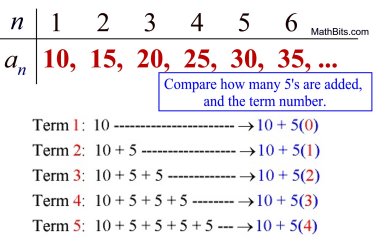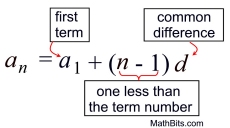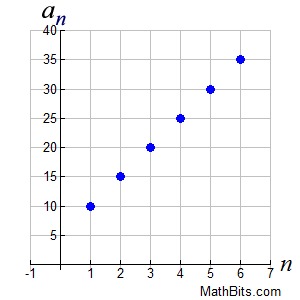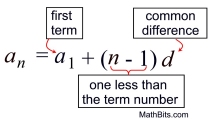|
There are several special types of sequences that can be classified as explicit sequences.
That is, sequences for which a formula can be used to determine any term.
The arithmetic sequence is one of these special types of explicit sequences.
Arithmetic Sequences |
 Add
Add |
The arithmetic sequence is based upon the addition of a constant value
to arrive at the next term in the sequence.
Consider the arithmetic sequence: {10, 15, 20, 25, 30, 35, ... }

The difference between one term and the next is a constant, called the common difference, d.
To find the common difference, subtract the first term from the second term.
The common difference may be either positive or negative.
For this sequence, the common difference is 5.
Term Number |
Term |
Subscript Notation |
1 |
10
|
a1 |
2 |
15
|
a2 |
3 |
20
|
a3 |
4 |
25
|
a4 |
5 |
30
|
a5 |
6 |
35
|
a6 |
n |
|
an |
|
This sequence is graphed in the first quadrant.
Sequences are graphed as a series of dots.
Remember that the domain consists of the natural numbers, {1, 2, 3, ...}, and the range consists of the terms of the sequence.
|
Notice that this sequence has a linear appearance. The rate of change between each of the points is "5 over 1". While the n value increases by a constant value of one, the an value increases by a constant value of 5 (for this graph).
This graph grows by equal differences over equal intervals
making it a discrete "linear" function.
(Remember, the graph of a discrete function is a series of dots.) |
|

 Repeatedly adding "d ": Repeatedly adding "d ":
we get the second term: a2 = a1+ d.
Adding another "d " to that second term, we get the third term: a3 = a1+ d + d = a1+ 2d .
By continuing this process, we can generate a symbolic arithmetic sequence:
| a1 , |
(a1 + d) , |
(a1 + 2d) , |
(a1 + 3d) , |
... , |
(a1 + (n - 1)d) |
| term 1 |
term 2 |
term 3 |
term 4 |
|
term n |
Note how (n - 1) popped out in relation to d.
The (n - 1) is needed since d was not added to obtain the first term.
The d started working with the second term.
From this pattern, we can see a formula emerge for the nth term: an = a1 +(n -1)d.
 |
We just generated a format for creating explicit formulas for arithmetic sequences.
(using the first term, a1, and the common difference, d)
an = a1 + (n -1)d YEA!!!!
|
 Arithmetic Sequence: an = a1 + (n -1)d Arithmetic Sequence: an = a1 + (n -1)d |

Finding an Explicit Formula for this Sequence
{ 10, 15, 20, 25, 30, 35, ... }
|
We know this is an arithmetic sequence (the same number, 5, is added to each term to get to the next term).
We have seen that trying to "find" an explicit formula for a sequence
might be difficult,
or even impossible.
But, if your sequence is arithmetic, you will be able to find the explicit formula easily.
Simply use the first term, a1, and the common difference, d,
in the format an = a1 +(n -1)d that we discovered in the section above.
|

|
Explicit formula: an = 10 + (n - 1)5
(simplified) an = 5n + 5
|
|
If you compare the term number with how many times the common difference, 5, is added, you will see a pattern for an explicit formula:
 To get the explicit formula, plug in the first term, 10, and the common difference, 5.
To get the explicit formula, plug in the first term, 10, and the common difference, 5.
an = 10 + (n - 1)5
|
|
Now that you have the explicit formula, find the 100th term of this sequence.
Replace n with 100 in the explicit formula: an = 10 + (n - 1)5
a100 = 10 + (100 - 1)5 = 10 + (99)5 = 10 + 495 = 505 ANSWER

 Summary of Finding an Explicit Formula for an Arithmetic Sequence. Summary of Finding an Explicit Formula for an Arithmetic Sequence.
|
Process of writing an explicit formula for an arithmetic sequence:
1. Determine if the sequence is arithmetic.
(Did you add, or subtract, the same amount from one term to the next?)
2. Find the common difference. (The number you add or subtract.)
3. Create an explicit formula using the pattern a1 + (n - 1)d.
(First term added to the product of the common difference and one less than the term number.)
an= a1 + (n - 1)d |
an = the nth term in the sequence
a1 = the first term in the sequence
n = the term number
d = the common difference. |
|
{10, 15, 20, 25, 30, 35, ...} |
first term = 10, common difference = 5
explicit formula: an= 10 + 5(n - 1)
= 10 + 5n - 5 = 5 + 5n or 5n + 5 |
|

 Working with Arithmetic Sequences:
 Find the common diffference. Find the common diffference.
| Arithmetic Sequence: |
Common Difference, d: |
{ 1, 6, 11, 16, 21, 26, ... } |
d = 5. A 5 is added to each term to arrive at the next term.
OR ... the difference a2 - a1 = 5. |
{ 10, 8, 6, 4, 2, 0, -2, -4, ... } |
d = -2. A -2 is added to each term to arrive at the next term.
OR ... the difference a2 - a1 = -2. |
|
d = -½. A -½ is added to each term to arrive at the next term.
OR ... the difference a2 - a1 = -½. |

 Find a specific term. Find a specific term.
| Arithmetic Sequence Formula: |
Requested Term: |
Find the 4th term of an arithmetic sequence if the first term is 2 and the common difference is 5. |
The sequence looks like: 2, __, __, x
Adding 5 between terms, we get: 2, 7, 12, 17
The fourth term is 17. |
Find the 30th term of the sequence
an= 3n - 2 |
n = 30 Substitute into the formula.
a30= 3(30) - 2 = 88 |
Find the first three terms of the arithmetic sequence
an= 9n - 21
What is the common difference?
|
a1 = 9(1) - 21 = -12.
a2 = 9(1) - 21 = -3.
a3 = 9(1) - 21 = 6
The common difference is 9.
|

 Using an explicit formula. Using an explicit formula.
| Arithmetic Sequence Formula: |
Explicit formula: |
If the first term of an arithmetic sequence is 8 and the second term is 13, find the 50th term. |
The common difference is 5.
Use: an = a1 + (n -1)d
a50 = 8 + (50-1)5 = 253
|
a1 = 30 and a2 = 24
Find an explicit formula for this sequence. |
d = -6
Use: an = a1 + (n -1)d
an = 30 + (n - 1)(-6) an= -6n + 36
|
The first three terms of an arithmetic sequence are 5, 17, and 29. Write a formula to express the nth term.
|
d = 12.
Use: an = a1 + (n -1)d
an = 5 + (n - 1)12 an= 12n - 7 |
For application word problems for sequences,
see BEWARE: Sequences and Word Problems
and
Examples of Working with Sequences.

Doubting Thomas wonders how we can know, for sure, that a sequence such as
{
2, 4, 6, 8, ...} is an arithmetic sequence. His theory is that there could be many other possible patterns, such as: { 2, 4, 6, 8, 2, 4, 6, 8, ... }(repeating 4 terms is his pattern).
|
Yes, Thomas is correct. Without a specification in the problem, there is the possibility of more than one pattern in most sequences. The person creating the sequence may have been thinking of a different pattern than what you see when you look at the sequence.
In Algebra 1, if in doubt, first look for arithmetic or geometric possibilities.
Math questions are usually not trying to trick you. |
 |
|
Arrow down to
"In Func MODE" |
|

NOTE: The re-posting of materials (in part or whole) from this site to the Internet
is copyright violation
and is not considered "fair use" for educators. Please read the "Terms of Use". |
|
|





 Arithmetic Sequence:
Arithmetic Sequence: 




